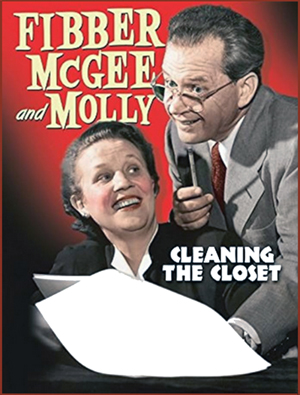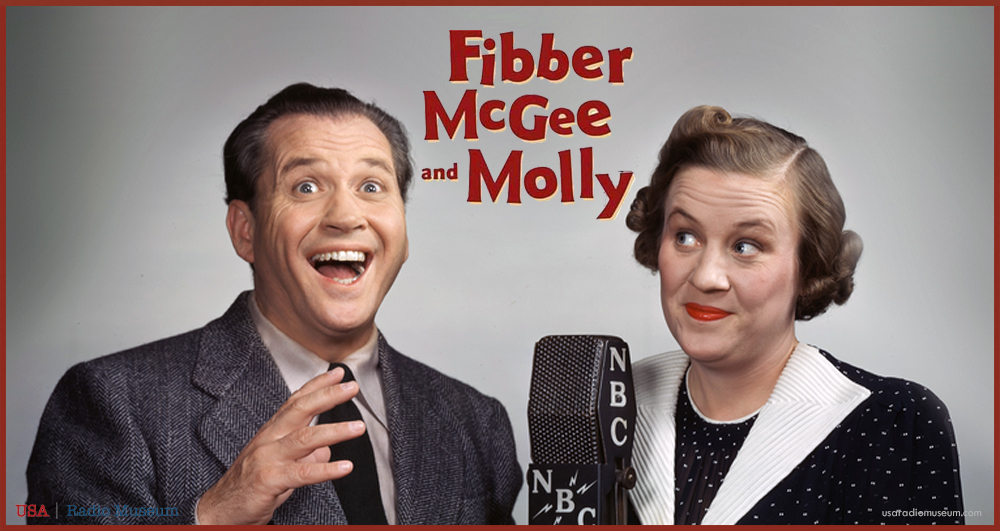Their Shows Became A Timeless Treasure of the Golden Age of Radio "Fibber McGee and Molly" is a fascinating piece of radio history. It was an
Their Shows Became A Timeless Treasure of the Golden Age of Radio
 “Fibber McGee and Molly” is a fascinating piece of radio history. It was an American radio comedy series that aired from 1935 to 1959, making it one of the most enduring and beloved shows of its time. The show followed the humorous escapades of Fibber McGee, a habitual storyteller, and his sensible yet loving wife, Molly, as they navigated life in the fictional town of Wistful Vista.
“Fibber McGee and Molly” is a fascinating piece of radio history. It was an American radio comedy series that aired from 1935 to 1959, making it one of the most enduring and beloved shows of its time. The show followed the humorous escapades of Fibber McGee, a habitual storyteller, and his sensible yet loving wife, Molly, as they navigated life in the fictional town of Wistful Vista.
The series was created and performed by Jim and Marian Jordan, a real-life husband-and-wife duo whose comedic chemistry was central to the show’s success. It became famous for its relatable humor, well-drawn characters, and iconic running gags which their show introduced to a new generation of radio listeners tuning in every week on NBC radio, from coast-to-coast.
At its peak in the 1940s, the show was a cultural phenomenon, even inspiring a series of feature films. It transitioned to a short-form format as part of the weekend program “Monitor” in its later years. Despite attempts to adapt it for television, the magic of “Fibber McGee and Molly” remained firmly rooted in the golden age of radio. In the annals of radio history, few programs captured the hearts and imaginations of audiences like their radio shows did. This beloved American radio comedy series became an enduring cultural touchstone during radio’s early-infancy years. Its relatable humor, colorful cast of characters, and innovative use of sound effects made it a household name and a symbol of entertainment for nearly a quarter-century.
The Premise and Appeal
The series centered around the lighthearted escapades of Fibber McGee, an affable but bumbling storyteller, and his practical, kind-hearted wife, Molly, in the fictional town of Wistful Vista. Portrayed by real-life husband-and-wife duo Jim and Marian Jordan, the characters’ chemistry and wit created a warm, entertaining atmosphere that resonated with listeners during some of the most challenging times in modern history, from the Great Depression to World War II.
Peak Popularity in the 1940s
The 1940s marked the zenith of the show’s success. With its relatable humor and iconic running gags, the program became a cultural phenomenon. One of its most famous recurring segments, “Fibber’s Closet,” debuted on March 5, 1940, and featured an overstuffed closet bursting open with a cacophony of sound effects whenever Fibber tried to retrieve something. This gag was so iconic that it entered the lexicon as a metaphor for disorganization.
Other highlights of the show included Fibber’s humorous tall tales, Molly’s affectionate exasperation captured in the phrase “T’aint funny, McGee!” and the antics of supporting characters like Mayor LaTrivia (played by Gale Gordon), the Old-Timer, and neighbor Gildersleeve (portrayed by Harold Peary).
FIBBER McGEE and MOLLY | Cleaning Fibber’s Closet | MARCH 5, 1940
Audio Digitally Enhanced by USA Radio Museum
Radio Network
The show was a staple of the NBC Red Network throughout its run. It originally debuted on the NBC Blue Network in 1935 but quickly moved to NBC Red in 1936, where it remained a prime-time favorite until 1956. The series continued in a short-form format as part of NBC’s weekend program Monitor from 1957 to 1959.
Behind the Scenes: The Jordans and Their Creative Team
Jim (1896–1988) and Marian Jordan (1898–1961) were the creative heartbeat of the series. Originally hailing from Peoria, Illinois, the couple met at their church choir and married in 1918. Their shared love of performance eventually led them to a career in radio, where they honed their craft in programs like Smackout before launching Fibber McGee and Molly.
Working with gifted writer Don Quinn, the Jordans brought to life a program that blended relatable domestic comedy with inventive sound effects and sharp dialogue. Marian’s portrayal of Molly as a voice of reason and Jim’s humorous portrayal of Fibber’s antics formed the core dynamic that endeared them to millions of listeners.
The Jordans began their radio careers in the 1920s, performing on local Chicago stations. Their big break came with the show Smackout in 1931, where they honed their comedic skills. This success paved the way for Fibber McGee and Molly, which debuted in 1935. Marian’s portrayal of the sensible and loving Molly complemented Jim’s bumbling and boastful Fibber, creating a dynamic that resonated with audiences.
The couple’s partnership extended beyond the microphone, as they collaborated closely with writer Don Quinn to craft the show’s witty and relatable scripts. Despite Marian’s health challenges in later years, the Jordans’ legacy as pioneers of radio comedy remains enduring. Marian passed away in 1961, and Jim continued to work in entertainment, even lending his voice to Disney’s The Rescuers in 1977.
Cultural and Historical Impact
Beyond its humor, the show offered solace and escapism to a nation facing economic hardship and global conflict. Its popularity was reflected in the vernacular, with phrases and gags from the show becoming widely recognized and referenced. The series also influenced the development of the sitcom genre, serving as a precursor to television classics like I Love Lucy and The Honeymooners. “Fibber McGee and Molly” was more than just a radio show; it was a cultural phenomenon. The show’s humor resonated with audiences during the Great Depression and World War II, offering a sense of comfort and escapism. It also helped shape the sitcom format, influencing later radio and television comedies.
Transition and Conclusion
As television rose to prominence, there were attempts to bring Fibber McGee and Molly to the small screen, though the Jordans themselves remained dedicated to the radio format. In the late 1940s and early 1950s, as television gained popularity, there were attempts to adapt Fibber McGee and Molly for the new medium. A 1959 pilot featured Bob Sweeney and Cathy Lewis as the iconic couple, but it failed to capture the magic of the original radio series. The Jordans themselves were reluctant to fully transition to television, as they believed the charm of the show lay in the theater of the mind created by radio. The show concluded its full-length run in 1956 but continued in short form as part of NBC’s weekend program Monitor until its final broadcast in 1959.
Honors and Legacy
In recognition of its impact, Fibber McGee and Molly was inducted into the Radio Hall of Fame in 1989, solidifying its place in the pantheon of American entertainment. The legacy of the Jordans and their work remains a cherished part of radio history, with over 1,400 episodes preserved and celebrated by enthusiasts [Note: the USA Radio Museum has all of them]. The legacy of Fibber McGee and Molly lives on in the Radio Hall of Fame, where it’s celebrated as a pioneering force in radio entertainment. Recordings of episodes continue to be cherished by fans and historians, preserving the laughter and warmth that made the show a cultural phenomena in radio’s earliest days.
Conclusion
Marian Jordan (Molly): Born on April 15, 1898, Marian passed away on April 7, 1961, just shy of her 63rd birthday. Jim Jordan (Fibber): Born on November 16, 1896, Jim lived a long life and passed away on April 1, 1988, at the age of 91.
The charm of Fibber McGee and Molly lies in its ability to transport listeners to a world where humor and warmth reign supreme. The show’s enduring appeal is a testament to the power of storytelling and the extraordinary talent of Jim and Marian Jordan. Whether it’s through the laughter inspired by Fibber’s tall tales or the crashing sound of that infamous closet, Fibber McGee and Molly remains a timeless treasure in the tapestry of American radio broadcasting that is still cherished to this day.

